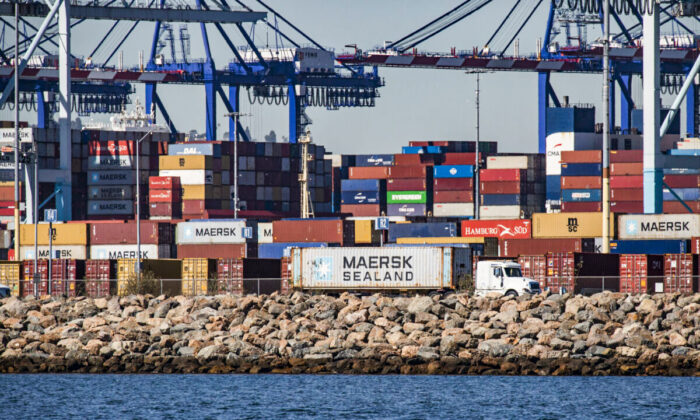By Andrew Moran
The global supply chain crisis continues to wreak havoc on the international marketplace, affecting everything from food products to computers and washing machines.
This year, the international supply chain has faced a plethora of challenges, including China’s renewed COVID-19 lockdowns, the military conflict in Eastern Europe, and skyrocketing energy prices. With disruption and uncertainty seeping into every facet of the worldwide supply chain, most companies expect current conditions to continue or even worsen by the end of 2022, a new report shows.
According to a study by QIMA, a global quality control and compliance service provider, nearly two-thirds of global businesses with international supply chains see these disruptions remain unchanged or get worse by the year’s end.
This number rises to 81 percent for U.S. firms and 80 percent for European organizations.
Companies are experiencing a broad array of issues. The top three challenges, the survey found, are sustaining production and shipping schedules, forecasting demand and managing inventory, and securing enough manufacturing capacity.
China’s COVID Zero strategy and subsequent lockdowns of key economic hubs have been the most impactful in 2022, the report revealed. In addition, businesses reported soaring raw materials, commodities, and labor costs and raw material shortages as having a large effect.
Separate QIMA data show that inspection and audit volumes tumbled 4.5 percent year-over-year in the first half of the year. Moreover, sourcing portfolios of brands continue to be at a three-year low.
“QIMA data on inspection and audit volumes, combined with the latest survey findings, shows that global buyers’ efforts to decrease their reliance from China continue, especially in the wake of the 2022 Covid-19 related lockdowns in the country, ranked among this year’s most impactful supply chain disruptions by the majority of the survey respondents,” the report noted.
But there is a gap between large and small firms, QIMA purported.
“Notably, the reliance on Chinese suppliers remains strongest among small and medium-sized businesses, which, compared to large multinationals, have fewer spare resources to swiftly shift sourcing volumes between countries or regions,” the study highlighted.
While supply chain experts have often discussed Vietnam and Thailand as integral markets for regional sourcing shifts, India benefited immensely during this transition. For example, in the first six months of 2022, inspections and audit demand posted a 41 percent gain in India.
Plus, India could witness even more business in the coming months as entities divert resources away from Sri Lanka amid the island nation’s economic collapse.
Overall, the report concludes that brands and retailers will understand that it will be imperative to “restructure their supply chains for greater agility and resilience,” mostly through diversification and better supplier partnerships.
A recent EY Industrial Supply Chain Survey revealed that companies are transforming their global supply chain operations, including “significant decoupling of existing supply chains.”
The EY study found that 53 percent of firms have already nearshored or reshored some of their supply chains since the beginning of the coronavirus pandemic. In addition, nearly half (44 percent) say that they are planning new or extra nearshoring efforts within the next 24 months. Fifty-seven percent have also launched new operations in one or more additional markets in the last two years to expand geographic diversity and mitigate risk.
“Global supply chains are undergoing a seismic shift as companies depart from the strategies that prioritized ultra-low costs, just-in-time delivery and bare minimum inventories,” EY stated.
China remains the leader in global supply chains, and, according to Kunal Sawhney, CEO of data science research firm Kalkine Group, it will be challenging for companies to move out of the world’s second-largest economy.
Federico Crespo, CEO and founder of Valiot, a software company that supports manufacturing firms with technological solutions, does not necessarily believe there is a great shift away from China. Instead, Crespo told The Epoch Times that companies are transitioning their operations amid COVID-related concerns and geopolitical tensions.
Based on what has been shoring over the last 18 months, Crespo noted that Texas has been a big winner during this period. But he thinks Latin America, including Mexico, could benefit from these trends as well.
He thinks there are multiple reasons for the latest changes in global supply chain management. For the most part, they are relocating their operations and adopting a more regional approach. This, Crespo says, can be beneficial as it can help with broader reshoring efforts.
In addition to Mexico, Sawhney thinks multiple nations could benefit from companies gradually leaving China, such as Bangladesh, India, Indonesia, Pakistan, the Philippines, and Vietnam. The United States and Canada could also enjoy notable gains.
Is the Supply Chain Crisis Easing?
But while much of the commentary paints a bleak picture of the global supply chain, Michael Field, a senior equity analyst for Morningstar, says the broader situation is improving.
Field writes that ocean freight reliability is getting better due to reduced delays, while air and sea freight capacity is increasing this year. Freight rates are also coming down, which could slightly trim international inflation rates. The underlying causes of the supply chain fiasco, from lockdowns to public health mandates, are dissipating.
This does not mean all of the supply chain problems will be resolved, Field explained.
“We are still exposed to exogenous shocks in the near term, with recent examples of the Russia-Ukraine war and the lockdown in Shanghai adding further strain to the system,” he wrote.
At the same time, Sawhney told The Epoch Times that there are multiple challenges currently facing the industry, including shortages, shipping costs, sluggish traffic, and even weaker demand.
But while nobody could have envisioned an international public health crisis, Sawhney contends that a majority of the global supply chain problems are “unprecedented.”
“For instance, the pandemic and the Russia-Ukraine war are events that do not fall into the usual predictable economic situations. The macroeconomic factors can be considered to prevent it in the future,” he said. “However, the unforeseen ones have to be dealt with measures that are suitable at the moment. The pandemic led to a shortage of drivers in the U.S. and other developed nations causing a major disruption to the supply chain.”
“So, there must be a global collaboration in taking up the measures to prevent it in the future. A contingency plan, identification of backup suppliers, and diversification of supply chain bases are some of the measures that may help to prevent it in the future,” he added.
The World Trade Organization (WTO) lowered its forecast for the growth of global merchandise trade volume in 2022. In light of the conflict in the Ukraine and the lockdowns in China, the group projects a growth of 3 percent, which is lower than its prior projection of 4.7 percent.






